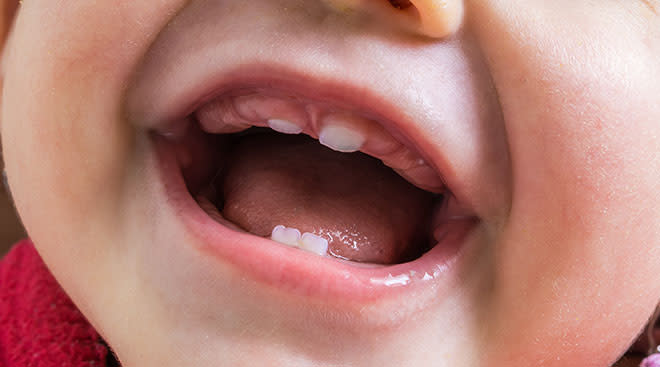When Can Babies Have Milk?
It’s an exciting milestone when baby is old enough to start transitioning from breast milk or formula to cow’s milk—but it’s important not to rush into it. (You want to make sure baby gets all the important nutrients—and introducing milk too early can actually do more harm than good.) So when can babies have milk, and what type of milk can they have? Read on to learn when and how to go about transitioning to milk to ensure a healthy diet for your child.
You know that infants need breast milk or formula for a while after birth, but you might still be wondering: When can babies drink cow’s milk? “Officially, milk can be a child’s primary drink at one year of age,” says Russell Horton, DO, a pediatrician at the Banner Health Center in Queen Creek, Arizona. This is consistent with recommendations from the American Academy of Pediatrics (AAP) and Centers of Disease Control and Prevention (CDC). For babies born prematurely, cow’s milk should be introduced at their corrected age of 12 months, notes Jen Graham, MS, RDN, a registered dietitian with Top Nutrition Coaching.
Before that milestone though, cow’s milk shouldn’t be a part of baby’s diet. “The protein and minerals in cow’s milk are more than what an infant’s kidneys can handle, so babies are unable to digest cow’s milk before this age,” explains Oklahoma-based pediatrician Denise Scott, MD. “The high protein in cow’s milk can lead to bleeding in the intestines and iron deficiency anemia if introduced too early,” she adds. Before the age of one, you’ll want to stick with infant formula or breast milk, which have more nutrients than regular cow’s milk.
Benefits of drinking cow’s milk for toddlers
Once your tot is ready to make the switch, milk will play an important role in your child’s healthy diet. According to the US Department of Agriculture, toddlers who consume milk and other dairy products get important nutrients necessary for their growth. Below, the USDA and Ali Bandier, MS, RD, CDN, a pediatric dietitian and founder of Senta Health, note some benefits of cow’s milk for toddlers:
- It provides nutrients like protein and potassium, as well as calories and fat that help with growth
- Cow’s milk contains important vitamins, including vitamins A, D and B12, which contribute to healthy bones, immune function and cell processes
- It contains calcium, which helps build strong bones and teeth
In addition, it helps to build healthy habits: Toddlers who start drinking milk at a young age are more likely to continue drinking milk when they’re older.
Once baby’s a year old, you can start to transition from formula to cow’s milk (or a milk alternative)—but understanding how to introduce cow’s milk is just as important as knowing when babies can have milk. Transitioning from formula to milk can be challenging at first, so don’t worry if a baby who eagerly drank bottles of formula or breast milk seems less than thrilled with cow’s milk. “Baby won’t chug it like they did with breast milk or formula, and that’s okay. It’s a beverage, not the mainstay of their nutrition,” says Ari Brown, MD, a pediatrician in Austin, Texas, and co-author of Baby 411.
Some babies don’t like the taste of cow’s milk at first, but there are a few things you can do to help them adjust when transitioning from formula to milk:
- Transition gradually: This helps your child get used to the taste of cow’s milk, Bandier explains. Plus, it helps prevent a disruption to your tot’s calorie and nutrient intake. She recommends mixing a little bit of formula or breast milk in with cow’s milk at the beginning. Bandier recommends doing a 50/50 mix for a few days or a week before offering 100 percent cow’s milk.
- Warm the milk: The cold temperature of milk can be a bit startling, especially if baby was used to the warmth of breast milk, Horton says. Try warming up the cow’s milk before offering it to baby (just be sure to check the temperature first to ensure it’s not too hot).
- Use a straw or sippy cup: All the experts recommend bottle weaning once baby starts drinking cow’s milk. That’s because a bottle’s nipple can cause problems with baby’s growing teeth, Horton explains. Plus, “if your toddler takes milk from the cup, it can be easier to wean off the breast or bottle,” Scott adds. That said, not all babies are ready to make both changes at once—and switching from a bottle to cup may be harder than switching to cow’s milk, Bandier says. She suggests using a cup your child loves and is excited about, and making the transition smoother by first switching to cow’s milk and then switching to a sippy cup.
When do babies stop drinking formula
How long do babies drink formula? According to Scott, babies can stop drinking formula after one year. If you have a box of infant formula, feel free to finish it or use it to help ease baby’s transition to cow’s milk, Bandier says. But it’s important to know that toddler formula is not the same as infant formula and doesn’t hold any nutritional value (more on this below).
Many parents also wonder if transitioning to cow’s milk means they need to stop breastfeeding. “Moms can still breastfeed while making the transition to [cow’s] milk,” Horton says, adding that the choice to stop breastfeeding is a personal decision, and there’s no deadline for when to wean baby. “As breastfeeding is decreased, the volume of milk offered can be increased,” Scott adds.
There are tons of milk alternatives available these days—“even among cow’s milk there are multiple options: lactose-free, hormone-free, A2 and organic,” Scott says. It naturally raises the question: Is there a type of best milk for one-year-olds? The AAP recommends whole cow’s milk for babies and toddlers. This is because of the balance of carbs, protein and fat. “It’s a great source of calcium and vitamin D, as well as saturated fat for developing brains,” says Graham.
That said, the AAP notes that 2 percent milk can also be a good option, depending on a child’s weight. This addendum was added in 2008 to help address the rise in childhood obesity. “Now we look at a 12- to 24-month-old’s growth chart to determine if whole or 2 percent is the best choice,” Brown says. After 2 years old, Horton says you can start to switch your tot to whatever type of milk the rest of your family drinks, but the AAP recommends transitioning to plain fat-free or low-fat milk for kids ages 2 to 5. If you still have concerns about the amount of fat your child is getting from milk and its impact on their weight, it’s always best to check in with your pediatrician.
Is organic cow’s milk preferred for toddlers?
Regardless of the fat content, you might be wondering how important it is that toddlers drink organic or non-organic cow’s milk. While organic foods have the same vitamins, minerals, antioxidants and other nutrients as conventional foods, the AAP found that they also have lower pesticide levels and are less likely to be contaminated with drug-resistant bacteria, which can offer significant benefits for kids. So is organic milk the better option? Not necessarily—in the aforementioned study, when comparing organic and conventional food items, the AAP failed to find any special long-term health benefit to consuming an organic diet. What you should be buying every time is pasteurized milk to prevent baby from getting salmonella, E. coli, listeria and other bacterial infections. “Raw milk from cows, goats or sheep can contain high amounts of harmful bacteria and shouldn’t be given to children,” Scott says.
The dairy aisle doesn’t just offer a variety of options for cow’s milk—these days there are a slew of non-dairy milks made from fruits (coconut milk), nuts (almond and cashew milk), grains (hemp, rice and oat milk) and other plants (soy milk). But can babies have almond milk? And are all of these other types of milks okay for baby? Plant and non-dairy milks aren’t recommended for kids under 5, the AAP notes. However, if you do have a kiddo that’s allergic to milk, offering certain plant-based dairy alternatives can be okay. “The only recommended alternatives are pea-protein milk or soy milk,” Graham says. “Cow’s milk alternatives not recommended are those low in protein, calcium and vitamin D, such as almond milk, oat milk, rice milk and coconut milk.”
Graham suggests looking for plant-based dairy alternatives that are fortified with calcium and vitamin D. Scott also recommends reading labels and looking for milk alternatives that are unsweetened, unflavored and have the highest fat content. “Toddlers shouldn’t drink low-fat alternatives until after age 2,” she says. Avoid any options with added flavors or sugars, as well as unpasteurized milk. Remember, if you’re going to try a different type of milk, run it by your pediatrician first.
Per the USDA’s 2020 dietary guidelines, toddlers over a year old who are no longer drinking infant formula should have between 1 and two-thirds to 2 cups of dairy daily. This could include cow’s milk, yogurt, fortified soy milk (if non-dairy milks have been approved by your pediatrician) and cheese, Bandier says. In the grand scheme of baby’s day, 2 cups doesn’t seem like a lot, but offering baby milk is different from giving infant formula or breast milk. Milk doesn’t become your child’s primary source of nutrition, and you don’t need to increase the amount much as baby grows. In fact, children aged 2 and 3 years should also have 2 cups of dairy daily, Bandier adds, while kids aged 4 to 8 should have around 2 and a half cups.
Wondering if it’s possible for your kiddo to be drinking too much milk? Horton says to limit your child’s cow’s milk intake to around 20 ounces per day. Anything beyond that can lead to iron deficiencies and anemia “due to the calcium and iron competing with each other for absorption,” Graham explains. Plus, if your kiddo drinks too much milk, they may not be hungry for other foods, which limits their nutrient intake, and the lack of fiber-containing foods may also cause constipation. “The way I like to approach milk is that it is a drink and not a meal replacement,” Bandier says. “At this age, the majority of your child’s calories and nutrition should be coming from solid foods.”
However, children should continue to drink milk throughout childhood to ensure they’re getting enough calcium and vitamin D, Scott says. “When children begin to potty train overnight, the bedtime cup of milk usually is eliminated,” Bandier adds. “[But] this doesn’t change their overall dairy or calcium needs.”
Sometimes toddlers don’t take to milk—not because of an issue with the taste, but because they have an allergy to cow’s milk or are lactose intolerant. Of course, there’s an important difference between an allergy and a lactose intolerance. “A food allergy reaction involves your immune system and is due to an overreaction to the ingested food, which triggers a whole host of nasty and potentially dangerous symptoms,” says Clifford Bassett, MD, medical director of Allergy & Asthma Care of New York and author of The New Allergy Solution. On the other hand, a food intolerance usually deals with the digestive system rather than the immune system. “A food intolerance, such as lactose intolerance, is caused by a lack of the enzyme lactase, which is required to help digest milk,” Bassett explains.
The biggest difference: While a lactose intolerance can cause a good deal of discomfort, it’ll never lead to a life-threatening reaction like anaphylaxis, which can be sparked by an allergy. Another difference is that with a milk allergy, all dairy products will induce symptoms, while with a lactose intolerance, some dairy products that are low in lactose—such as yogurt and certain cheeses, like cheddar, Parmesan and Swiss—may not cause problems. According to Bassett, about 2 to 3 percent of children under 3 are allergic to milk. Lactose intolerance in infancy is rare but becomes more common with age: It’s estimated that about 65 percent of people have a reduced ability to digest lactose after infancy.
Symptoms of a toddler milk allergy
How can you tell if your child has an actual milk allergy? Sometimes having eczema as a young infant may be a sign, Scott says. But, oftentimes, parents may not discover baby’s allergy until they try to transition to milk. According to experts, the most common symptoms of a milk allergy are:
- Hives or welts, usually around the mouth, neck and upper chest
- Itchy mouth
- Redness all over the body
- Swelling of the mouth and face (specifically the eyes, lips and ears during more severe reactions)
- Sudden onset of vomiting or spit up
- Coughing or wheezing after drinking milk
- Diarrhea
- Stool with streaks of blood or mucus
- Fussiness (likely due to gas and stomach cramping)
In severe, emergency cases, milk allergies can also cause anaphylaxis, symptoms of which include difficulty breathing, severe swelling and hives, Graham says.
Symptoms of a toddler milk intolerance
On the other hand, the symptoms for lactose intolerance tend to be less severe. The experts say they include the usual suspects when dealing with an upset stomach, such as:
- Bloating
- Cramping
- Gas
- Diarrhea or loose stools
- Nausea
“There are no skin rashes that occur with lactose intolerance,” says Sujan Patel, MD, a pediatric allergist and immunologist based in New York City.
How to address milk allergies and intolerance
If you suspect your toddler has a milk allergy, it’s best to see a pediatric allergist and have them tested. One option is a diagnostic skin test, during which a small amount of milk extract is inserted into the skin. Within 15 minutes you’ll know if your child is allergic to milk. Another diagnostic option is a blood test, which can help pinpoint the likelihood of an allergic reaction to cow’s milk, Bassett says.
If your child is allergic to cow’s milk, other mammalian-based milks like goat or ewe milk are likely off the table too, because the proteins in these types of milk are very similar to those found in cow’s milk. But the good news is that it’s unlikely your toddler would be allergic to plant-based and non-dairy milk options, Patel says. Talk to your pediatrician to see if these milk types are safe alternatives.
It’s also important to know that a milk allergy may not last a lifetime. “About 80 percent of children will outgrow their milk allergy by age 16, and a majority of those children will outgrow it by kindergarten,” Patel says.
Allergies and intolerances aside, sometimes tiny tots won’t drink milk simply because they don’t like its taste or texture. In situations like these, it’s best to reach out to your pediatrician to confer about offering your child a milk alternative, Bandier says. But if cow’s milk and non-dairy options are off the table, then it’s important to ensure your child is meeting their daily calcium and vitamin D needs with their diet. Kids aged one to 3 years old need 700 mg of calcium per day, Bandier says, while children aged 4 to 8 years need 800 mg, the AAP notes. “For reference, one cup of cow’s milk has about 300 mg of calcium, one cup of yogurt has about 415 mg of calcium and one cup of raw spinach has about 245 mg of calcium,” Bandier adds.
Scott and Graham suggest the following foods for calcium:
- Cheese
- Yogurt
- Greens and leafy vegetables (spinach, beets, turnips, kale, collard greens)
- Soy products
- Dried figs
- Navy beans
- Chickpeas
- Macaroni and cheese
- Pudding
- Tofu
- Calcium-fortified cereal
For vitamin D, both experts recommend the following food items:
- Seafood, like salmon or sardines (just watch for bones and consider mashing to prevent choking, Graham says)
- Egg yolks
- Beef liver
- Yogurt
- Vitamin D-fortified cereals
- Vitamin D-fortified juices (these should be limited, Scott says)
Scott says that parents of kids who won’t drink milk should consider dietary supplements. “Milk and dairy are the primary sources of calcium and vitamin D in childhood and adequate amounts will protect their bones for the future,” Scott says. “If dairy is lacking in your child’s diet, discuss with your pediatrician to see if a supplement is needed.”
Can I give baby cow’s milk before 12 months?
As mentioned above, babies can’t drink cow’s milk prior to 12 months, all the experts and AAP note. But, before this age, they can have it cooked in foods (i.e. soups, baked goods, etc.) once they start solids, Bandier says.
When can baby have other dairy products?
Certain dairy products, such as yogurt and certain cheeses can be offered to babies younger than one year, Scott says. Usually, these dairy products are okay to offer after 6 months, Graham adds.
Are there benefits of continuing formula after one year?
When it comes to toddler formula vs milk, cow’s milk is the better option for babies over one. While infant formula can be used to ease baby’s transition to cow’s milk, the AAP released a statement in 2023 saying toddler formulas meant for children one year and older offer no nutritional benefit. “Toddler formulas are not necessary and don’t offer any nutritional advantages over switching to milk,” Scott says. “They don’t have as much protein as cow’s milk, may have added sugar and salt and are not FDA regulated.” That said, there are benefits to extended breastfeeding. You can offer cow’s milk and continue to breastfeed.
Please note: The Bump and the materials and information it contains are not intended to, and do not constitute, medical or other health advice or diagnosis and should not be used as such. You should always consult with a qualified physician or health professional about your specific circumstances.
Plus, more from The Bump:
Ali Bandier, MS, RD, CDN, is a pediatric dietitian and founder of Senta Health. She earned her master’s degree in nutrition from Columbia University and completed her training at Children’s Hospital Los Angeles. She is certified as a maternal and child health leader by California’s Leadership Education in Neurodevelopmental and Related Disabilities program.
Clifford Bassett, MD, is the medical director of Allergy & Asthma Care of New York and author of The New Allergy Solution. He earned his medical degree from State University of New York and completed his residency at Hackensack Medical Center in New Jersey.
Jen Graham, MS, RDN, CSP, LD/N, is a registered dietitian with over 12 years of experience, specializing in pediatrics and maternal health. She practices at Top Nutrition Coaching and founded Family Circle Nutrition, located in Florida. She earned her master’s degree in nutrition and dietetics from University of North Florida.
Russell Horton, DO, is a pediatrician with over a decade of experience at the Banner Health Center in Queen Creek, Arizona. He earned his medical degree from Arizona College of Osteopathic Medicine of Midwestern University.
Sujan Patel, MD, is a pediatric allergist and immunologist in New York City. He received his medical degree from Medical University of Lublin.
Denise Scott, MD, is a pediatrician with JustAnswer and a pediatric endocrinologist based in Oklahoma with over 30 years of experience. Certified in culinary medicine, Scott also runs the blog Feed Future Health and is the author of Feed Your Child’s Future Health: Prevent Disease Before It Starts. She received her medical degree from the University of Texas Medical Branch and completed her residency at the University of Oklahoma Health Sciences Center with a fellowship at the National Institutes of Health.
Healthy Children (American Academy of Pediatrics), Why Do Infants Need Baby Formula Instead of Cow's Milk?, September 2023
Centers for Disease Control and Prevention, Cow’s Milk and Milk Alternatives, May 2022
My Plate (US Department of Agriculture), Dairy
American Academy of Pediatrics, Healthy Beverage Quick Reference Guide
American Academy of Pediatrics, American Academy of Pediatrics weighs in for first time on organic foods for children, October 2012
US Department of Agriculture, Dietary Guidelines for Americans: 2020-2025, December 2020
Learn how we ensure the accuracy of our content through our editorial and medical review process.
Navigate forward to interact with the calendar and select a date. Press the question mark key to get the keyboard shortcuts for changing dates.




















































